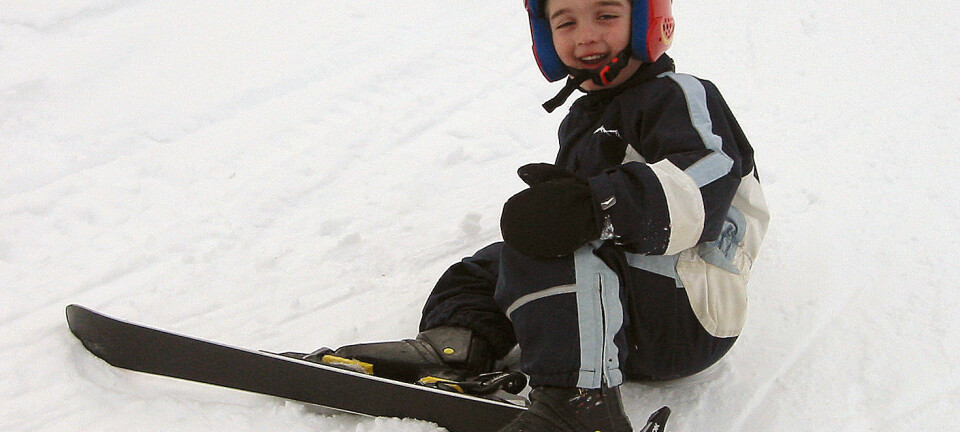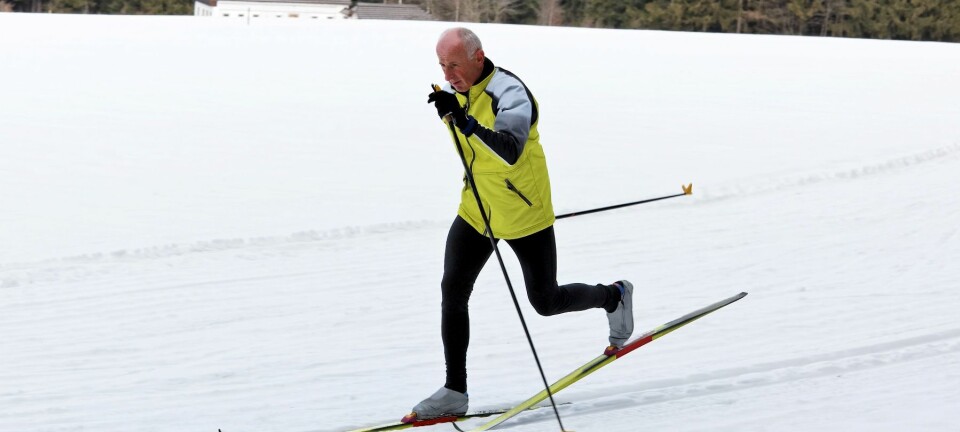An article from Norwegian SciTech News at SINTEF

The right high-performance skiwear
Cross-country skiers have always been focused on their skis and how they are waxed for the best performance. But competitive skiers should pay more attention to what they wear.
Denne artikkelen er over ti år gammel og kan inneholde utdatert informasjon.
There's no question that the right clothing can help skiers perform better, but new research from SINTEF shows exactly what that sportswear has to do help skiers do their best. If skiers wearing modern competition skiwear want to achieve peak performance, the temperature around their bodies should be between +1 and -4 degrees. If it is colder or warmer, the length of time before they are exhausted is reduced, and their performance suffers.
The reason for this is that our average skin temperature rises and falls in step with our surroundings.
”If our skin temperature is too low, our muscle temperature falls, our joints and ligaments stiffen, and the enzyme activity in our cells is changed”, says health researcher Mariann Sandsund at SINTEF Technology and Society.
"At the other extreme, high skin temperatures mean that sweat production increases. This leads to greater fluid loss and dehydration which in turn have a negative impact on our performance,” she says. This is why it is important to wear clothing that can minimise these changes in our bodies.
Always the same ski suit
The SINTEF researchers began their investigation in 2009 when they interviewed skiers from the Norwegian national team and skiing students from Heimdal and Meråker upper secondary schools about their views on the skiwear they used during training and competition.
The skiers said that they normally wore their ski suits, but that they would vary the layers they wore under their suits depending on the temperature.
Based on the feedback from the skiers as to what they felt functioned well and less well, researchers carried out a field study in Trondheim with a different group of eight highly-trained skiers to study core and skin temperatures under simulated competition conditions. They found that the hands, chest and thighs were especially subject to over-cooling.
Cold lab
The next step was to carry out a larger study at SINTEF’s Work Physiology lab involving participants from the cross-country skiers group at NTNUI, the sports association at the Norwegian University of Science and Technology. These were highly-trained young people well used to pushing themselves in training and competition.
They were asked to run on a treadmill until they were completely exhausted. The studies took place under six different temperature conditions varying from -14 to +20 degrees, and in winds of 5 metres per second. Sensors and thermometers were attached to the bodies of the participants.
”We succeeded in finding the peak performance temperature window”, says Sandsund. ”No one had managed to demonstrate the relation between peak performance and temperature for cross-country skiers before.”
“When we started our investigations we had no idea where the peak performance temperature window would be for modern ski suits,” she added.
Less efficient in the cold
It was one thing for the researchers to determine the peak performance temperature window based on measurements of how long it took a skier to become exhausted. The next was to study the impact on physiological mechanisms.
They looked into how different temperatures affected maximum oxygen uptake, lactic acid thresholds, and what it cost the skier in terms of work economy to complete the exercise.
”Here we observed that the test individuals achieved maximum oxygen uptake regardless of temperature, but they couldn’t maintain this uptake over time under extreme temperature conditions. We saw that when it becomes cold it costs the body more to perform work – it simply functions less efficiently,” says researcher Øystein Wiggen, who has been working on the same project.
A treasure trove of data
The research from ”Sport in Cold Climates” has been incorporated into SINTEF's “ColdWear” project, in which clothing, temperature conditions and peak performance capabilities are the common denominators in studies linked to sports and the petroleum industry.
Øystein Wiggen has continued his studies of sports and the relation to cold as part of his doctoral thesis, and has been looking into performance linked to double-poling techniques and upper body work using the cold chamber at the Work Physiology Laboratory. He has studied both endurance tests of up to 20 minutes and short sprints from 30 seconds to 2 minutes.
”We have always wanted to make the tests more realistic, and we know that modern cross-country skiing is very dependent on upper body work,” says Wiggen, who has run trials with test individuals in temperatures from +5 to -15 degrees. The results showed that performance declined by between 2 and 3 per cent in cold conditions.
Four NTNU master's students have also been working on topics related to the research project, which now has a considerable treasure trove of data.
Swix updated
The Norwegian ski wax and sportswear company Swix Sport AS has been kept informed of the results, and has had access to the project's data. In 2011 the company introduced a new World Championship suit for cross-country skiers, the development of which was based on SINTEF research.
Sandsund and Wiggen say the the project clearly demonstrates that modern cross-country ski clothing is optimal in temperatures just under 0°C, but is far from ideal under all temperature conditions.
Norwegian skiing star Petter Northug has himself said that he can’t race wearing too many layers. ”Perhaps we should now simply be thinking in terms of the benefits of selecting our skiwear according to the conditions,” says Wiggen.
































